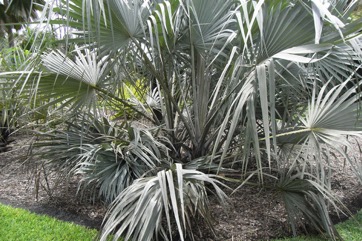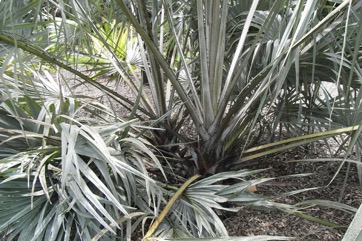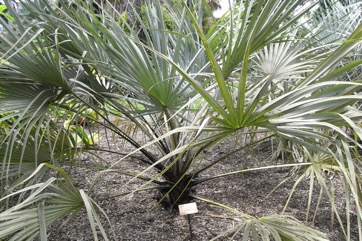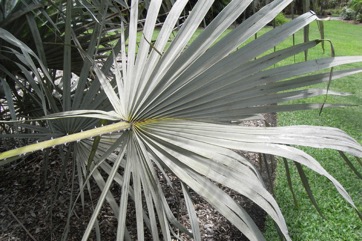Doum palm, Vegetable ivory palm

A tropical plant. It grows in tropical southern Africa. It grows in open savannah and along streams and rivers. It can grow in salty soil. It can re-grow after fire. It grows between 275-1,300 m above sea level. It can grow in arid places. It grows in Miombo woodland in Africa. It suits hardiness zones 10-12.
Also known as:
Fan palm, Ilala palm, Kambili, Lallo, Makalani palm, Manganda, Mlala, Mokola palm, Mokolowane, Murara, Northern Ilala palm, Omulunga, Omurungu, Palem gading sayur, Real fan palm, Vegetable ivory
Synonyms
- Chamaeriphes benguelensis (Welw. ex H. Wendl.) Kuntze
- Chamaeriphes ventricosa (Kirk) Kuntze
- Hyphaene aurantiaca Dammer
- Hyphaene benguellensis Welw. ex Wendl.
- Hyphaene bussei Dammer
- Hyphaene goetzei Dammer
- Hyphaene obovata Furtado
- Hyphaene ovata Furtado
- Hyphaene plagiocarpa Dammer
- Hyphaene ventricosa J. Kirk
Edible Portion
- Nuts, Bud, Sap, Fruit, Seeds, Sprouts
Where does Doum palm grow?
Found in: Africa, Angola, Asia, Botswana, Burundi, Central Africa, Congo, East Africa, Indonesia, Malawi, Mozambique, Namibia, Rwanda, SE Asia, South Africa, Southern Africa, Tanzania, West Africa, Zambia, Zimbabwe
Notes: There are about 9 or 10 Hyphaene species. (Some authorities estimate 40).
Growing Doum palm, Vegetable ivory palm
Cultivation: Plants can be grown from seeds.
Edible Uses: The flower bud can be tapped for sap used to make wine. The stem is tapped near the growing tip and the sap used to make wine. (It kills the palm). The palm heart is edible. The core of young trunks can be used as a vegetable. The layer around the fruit is eaten raw. The young fruit are boiled and eaten. The nut or kernel is soaked and eaten raw. The 'milk' like coconut milk can be drunk.
Production: For sap, all the leaves are removed and the stem tip cut at an angle to start the sap flowing. The flow can be continued for 7 weeks by regularly cutting. The yield can be 8-60 litres. One tree can produce 20 to 50 kg of fruit.
Nutrition Info
per 100g edible portion| Edible Part | Energy (kcal) | Protein (g) | Iron (mg) | Vitamin A (ug) | Vitamin c (mg) | Zinc (mg) | % Water |
|---|---|---|---|---|---|---|---|
| Fruit | 303 | 4.9 | 2 | - | 19.7 | 0.6 | 6.6 |
| - | - | - | - | - | - |
Doum palm, Vegetable ivory palm Photos




References
Baidu-Forson, J.J., et al ,2014,. Assessment of agrobiodiversity resources in the Borotse flood plain, Zambia. CGIAR Research Program on Aquatic Agricultural Systems. Penang, Malaysia. Working Paper: AAS-2014-12. (As Hyphaene ventricosa)
Balick, M.J. and Beck, H.T., (Ed.), 1990, Useful palms of the World. A Synoptic Bibliography. Colombia p 531, 532, 542, (As Hyphaene ventricosa)
Cheikhyoussef, A & Embashu, W., 2013, Ethnobotanical knowledge on Indigenous fruits in Ohangwena and Oshito regions in Northern Namibia. Journal of Ethnobiology and Ethnomedicine 9:34
Etherington, K., & Imwold, D., (Eds), 2001, Botanica's Trees & Shrubs. The illustrated A-Z of over 8500 trees and shrubs. Random House, Australia. p 390
FAO, 1988, Traditional Food Plants, FAO Food and Nutrition Paper 42. FAO Rome p 333
Fowler, D. G., 2007, Zambian Plants: Their Vernacular Names and Uses. Kew. p 64
Fox, F. W. & Young, M. E. N., 1982, Food from the Veld. Delta Books. p 100 (As Hyphaene ventricosa)
Grivetti, L. E., 1980, Agricultural development: present and potential role of edible wild plants. Part 2: Sub-Saharan Africa, Report to the Department of State Agency for International Development. p 70, 72 (As Hyphaene ventricosa)
Haynes, J., & McLaughlin, J., 2000, Edible palms and Their Uses. University of Florida Fact sheet MCDE-00-50-1 p 6
http://www.fao.org/forestry/25323-096344a3de335832e8f363c3ac5184a66.pdf (As Hyphaene ventricosa)
INFOODS:FAO/INFOODS Databases
Jardin, C., 1970, List of Foods Used In Africa, FAO Nutrition Information Document Series No 2.p 83
Johnson, D.V., 1998, Tropical palms. Non-wood Forest products 10. FAO Rome. p 20
Jones, D.L., 1994, Palms throughout the World. Smithtonian Institution, Washington. p 229
Le Houerou, H. N., (Ed.), 1980, Browse in Africa. The current state of knowledge. International Livestock Centre for Africa, Ethiopia. p 163 (As Hyphaene ventricosa)
Malaisse, F., 1997, Se nourrir en floret claire africaine. Approche ecologique et nutritionnelle. CTA., p 63
Mannheimer, C. A. & Curtis. B.A. (eds), 2009, Le Roux and Muller's Field Guide to the Trees and Shrubs of Namibia. Windhoek: Macmillan Education Namibia. p 4
Maroyi, A. & Cheikhyoussef, A., 2017, Traditional knowledge of wild edible fruit in southern Africa: A comparative use patterns in Namibia and Zimbabwe. Indian Journal of Traditional Knowledge. 16(3): 385-392
Menninger, E.A., 1977, Edible Nuts of the World. Horticultural Books. Florida p 135
Neelo, J., et al, 2015, Ethnobotanical Survey of Woody Plants in Shorobe and Xobe Villages, Northwest Region of Botswana. Ethnobotany Research & Applications 14:367-379
Neudeck, L. et al, 2012, The Contribution of Edible Wild Plants to Food Security, Dietary Diversity and Income of Households in Shorobe Village, Northern Botswana. Ethnobotany Research & Applications 10:449-462
Palmer, E and Pitman, N., 1972, Trees of Southern Africa. Vol. 1. A.A. Balkema, Cape Town p 353
Palgrave, K.C., 1996, Trees of Southern Africa. Struik Publishers. p 68 (As Hyphaene benguellensis)
Peters, C. R., O'Brien, E. M., and Drummond, R.B., 1992, Edible Wild plants of Sub-saharan Africa. Kew. p 38
Riffle, R.L. & Craft, P., 2003, An Encyclopedia of Cultivated Palms. Timber Press. p 354
Roodt, V., 1998, Trees & Shrubs of the Okavango Delta. Medicinal Uses and Nutritional value. The Shell Field Guide Series: Part 1. Shell Botswana. p 15
Royal Botanic Gardens, Kew (1999). Survey of Economic Plants for Arid and Semi-Arid Lands (SEPASAL) database. Published on the Internet; http://www.rbgkew.org.uk/ceb/sepasal/internet [Accessed 5th May 2011]
Ruffo, C. K., Birnie, A. & Tengnas, B., 2002, Edible Wild Plants of Tanzania. RELMA p 392
Ruiters-Welcome, A. K., 2019, Food plants of southern Africa. Ph.D. thesis. Univ. of Johannesburg p 29
Schmidt, E., Lotter, M., & McCleland, W., 2007, Trees and shrubs of Mpumalanga and Kruger National Park. Jacana Media p 56
Sukarya, D. G., (Ed.) 2013, 3,500 Plant Species of the Botanic Gardens of Indonesia. LIPI p 782
Tredgold, M.H., 1986, Food Plants of Zimbabwe. Mambo Press. p 106 (As Hyphaene benguellensis)
van Wyk, B, van Wyk, P, and van Wyk B., 2000, Photographic guide to Trees of Southern Africa. Briza. p 180
Van Wyk, Br. and van Wyk P., 2009, Field Guide to Trees of Southern Africa. Struik Nature. p 52
van Wyk, B., 2005, Food Plants of the World. An illustrated guide. Timber press. p 213
van Wyk, Be., & Gericke, N., 2007, People's plants. A Guide to Useful Plants of Southern Africa. Briza. p 106
Vickery, M.L. and Vickery, B., 1979, Plant Products of Tropical Africa, Macmillan. p 99
Wehmeyer, A. S, 1986, Edible Wild Plants of Southern Africa. Data on the Nutrient Contents of over 300 species.
Wickens, G.E., 1995, Edible Nuts. FAO Non-wood forest products. FAO, Rome. p166
Williamson, J., 2005, Useful Plants of Malawi. 3rd. Edition. Mdadzi Book Trust. p 137 (As Hyphaene ventricosa)
World Checklist of Useful Plant Species 2020. Royal Botanic Gardens, Kew
www.zimbabweflora.co.zw 2011